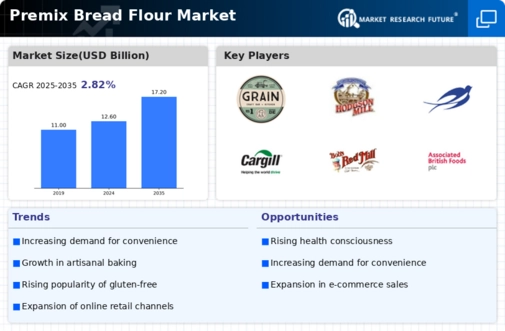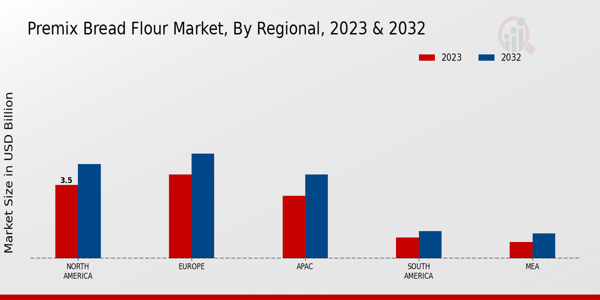Market Growth Projections
The Global Premix Bread Flour Market Industry is projected to experience substantial growth, with estimates indicating a market size of 12.6 USD Billion in 2024 and a potential increase to 17.2 USD Billion by 2035. This growth trajectory suggests a compound annual growth rate of 2.83% from 2025 to 2035. Such projections highlight the increasing consumer inclination towards premix solutions, driven by convenience, health trends, and the expansion of retail channels. As the market evolves, it appears poised for continued development, reflecting broader shifts in consumer behavior and preferences.
Health and Wellness Trends
The Global Premix Bread Flour Market Industry is significantly influenced by the growing health and wellness trends among consumers. There is an increasing awareness regarding nutritional content, leading to a demand for healthier baking options. This includes the incorporation of whole grains, gluten-free alternatives, and organic ingredients in premix bread flour products. As consumers prioritize health-conscious choices, manufacturers are adapting their offerings to meet these preferences. This shift not only caters to health-oriented consumers but also positions the market for growth, with projections indicating a market size of 17.2 USD Billion by 2035.
Expansion of Retail Channels
The Global Premix Bread Flour Market Industry is witnessing an expansion of retail channels, which is facilitating greater accessibility for consumers. Traditional grocery stores, specialty baking shops, and online platforms are increasingly stocking a diverse range of premix bread flour products. This expansion is particularly beneficial in regions where consumers may have limited access to specialty baking ingredients. The rise of e-commerce has also enabled consumers to explore various brands and products from the comfort of their homes, thereby driving sales and market growth. This trend is expected to further enhance the visibility and availability of premix bread flour in the coming years.
Consumer Interest in Artisan Baking
The Global Premix Bread Flour Market Industry is benefiting from a growing consumer interest in artisan baking. As more individuals engage in home baking as a hobby, there is an increasing demand for high-quality premix bread flour that can replicate artisanal bread-making results. This trend is fueled by social media platforms showcasing homemade bread, inspiring consumers to experiment with different recipes. Manufacturers are responding by offering specialized premix blends that cater to this market segment, thus enhancing product differentiation. The continued interest in artisan baking is likely to sustain growth in the premix bread flour sector.
Rising Demand for Convenience Foods
The Global Premix Bread Flour Market Industry is experiencing a notable increase in demand for convenience foods, driven by changing consumer lifestyles. As urbanization continues to rise, consumers are seeking quick and easy meal solutions, leading to a surge in the popularity of premix bread flour. This trend is particularly evident in regions with busy urban centers where time constraints influence food preparation choices. The market is projected to reach 12.6 USD Billion in 2024, reflecting a growing inclination towards ready-to-use baking solutions that simplify the bread-making process while maintaining quality.
Technological Advancements in Food Processing
Technological advancements in food processing are playing a crucial role in the Global Premix Bread Flour Market Industry. Innovations in milling technology and ingredient formulation are enhancing the quality and consistency of premix bread flour products. These advancements allow for better shelf life, improved flavor profiles, and greater ease of use for consumers. Furthermore, automation in production processes is streamlining operations, reducing costs, and increasing efficiency. As a result, manufacturers are better equipped to meet the evolving demands of the market, potentially contributing to a compound annual growth rate of 2.83% from 2025 to 2035.
























Leave a Comment